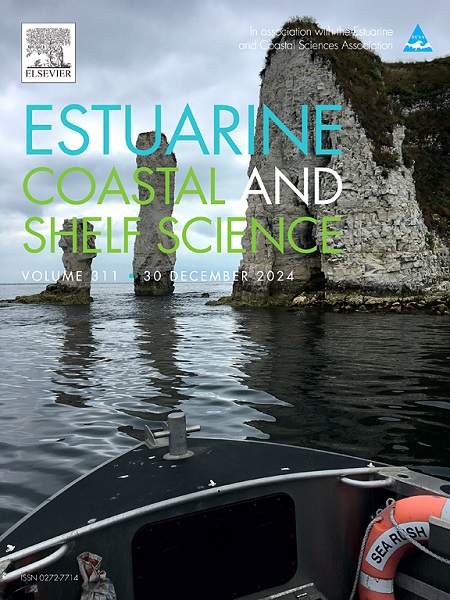频繁或大量沉积物供应对沉积物氧化还原动力学的影响:微观模拟
IF 2.6
3区 地球科学
Q1 MARINE & FRESHWATER BIOLOGY
引用次数: 0
摘要
海洋海岸环境受沉积事件的影响,例如浊积物、大潮和河口洪水。沉积物中的生物地球化学稳定性已被证明在新沉积层沉积后被破坏。本研究旨在通过微观模拟,了解不同强度和频率的沉积事件后早期成岩过程的连续恢复阶段。在为期五周的每周采样期间,采用高空间分辨率方法来表征氧、氮、锰和铁的行为,以响应i)单个2.7 cm沉积物(“一次性高容量”;OHV)和ii)一系列每周0.4 cm厚的沉积物(“频繁低体积”;FLV),与未受干扰的控制微观世界相比。结果表明,在FLV和对照微观环境中,孔隙水中氧、铵和亚硝酸盐浓度具有相似的垂直分布。在OHV微观世界中,氧渗透深度在3周后恢复到控制水平,而新沉积沉积物中的反硝化锋在扰动后一周内重新建立。对于锰和铁,OHV和FLV处理均表明,Mn/Fe氧化物富集的表面层在沉积物沉积后变为缺氧,引发细菌对这些氧化物的还原。溶解锰生产发生在溶解铁生产前一周,突出了优先的有机质再矿化途径。这些发现表明,沉积物沉积的瞬态生物地球化学响应因此可以通过锰和铁的循环来理解。本文章由计算机程序翻译,如有差异,请以英文原文为准。

Effects of frequent or massive sediment supplies on sediment redox dynamics: a microcosm simulation
Marine coastal environments are subject to depositional events generated for instance by turbidites, spring tides and estuarine floods. Biogeochemical stability in sediments was already shown to be disrupted following the deposition of a new sediment layer. The present study aims to understand the successive recovery stages of early diagenetic processes following sediment deposition events of varying intensity and frequency, using microcosms simulations. Over a five-week period with weekly sampling, high spatial resolution methods were applied to characterize the behavior of oxygen, nitrogen, manganese and iron in response to i) a single 2.7 cm sediment deposit (“one-time high volume”; OHV) and ii) a series of weekly 0.4 cm thick deposit (“frequent low volume”; FLV), compared to an undisturbed control microcosm. Results indicate that oxygen, ammonium and nitrite concentration in porewaters exhibited similar vertical distributions in FLV and control microcosms. In the OHV microcosm, oxygen penetration depth was returned to control levels after 3 weeks, whereas denitrification fronts within the newly deposited sediments reestablished within one week after disturbance. Regarding manganese and iron, both OHV and FLV treatments showed that the Mn/Fe oxide-enriched surface layer became anoxic after sediment deposition, triggering bacterial reduction of these oxides. Dissolved manganese production occurred one week before dissolved iron production, highlighting preferential organic matter remineralization pathways. These findings suggest that the transient biogeochemical response to sediment deposition can therefore be appreciated through manganese and iron cycling.
求助全文
通过发布文献求助,成功后即可免费获取论文全文。
去求助
来源期刊
CiteScore
5.60
自引率
7.10%
发文量
374
审稿时长
9 months
期刊介绍:
Estuarine, Coastal and Shelf Science is an international multidisciplinary journal devoted to the analysis of saline water phenomena ranging from the outer edge of the continental shelf to the upper limits of the tidal zone. The journal provides a unique forum, unifying the multidisciplinary approaches to the study of the oceanography of estuaries, coastal zones, and continental shelf seas. It features original research papers, review papers and short communications treating such disciplines as zoology, botany, geology, sedimentology, physical oceanography.

 求助内容:
求助内容: 应助结果提醒方式:
应助结果提醒方式:


